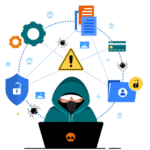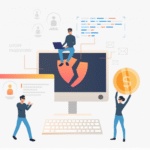Introduction
In today’s fast-paced business environment, the role of Chief Information Officers (CIOs) has evolved beyond just managing IT infrastructure and systems. They are now at the forefront of leading digital transformation, guiding their organizations through technological shifts to remain competitive, efficient, and innovative. However, with the acceleration of digital transformation, security concerns are also growing, making it crucial for CIOs to integrate robust security strategies into their transformation initiatives.
This article explores how CIOs can lead secure digital transformation with confidence, ensuring that their organizations harness the full potential of new technologies while safeguarding sensitive data and maintaining compliance. We will discuss the importance of digital transformation, the evolving role of CIOs, key challenges they face, and practical steps to ensure security throughout the digital journey.
What is Digital Transformation?
Before delving into how CIOs can secure digital transformation, it is important to define what digital transformation truly means. Digital transformation refers to the integration of digital technologies into all aspects of a business. This transformation involves not just adopting new technologies like cloud computing, AI, and automation, but also rethinking how businesses operate, engage with customers, and deliver value.
In essence, digital transformation is about embracing change, driving innovation, and improving business processes through the strategic use of technology. However, as organizations increasingly rely on digital tools, they expose themselves to potential vulnerabilities, making security a top priority for any CIO overseeing such a transformation.
The Evolving Role of CIOs in Digital Transformation
The role of the CIO has shifted dramatically over the years. Traditionally, CIOs were tasked with overseeing IT infrastructure, managing data centers, and ensuring system uptime. Today, their responsibilities extend far beyond these areas. They are now seen as leaders in driving strategic digital initiatives that align with overall business goals.
Digital transformation has made CIOs responsible for ensuring that technology investments support long-term objectives, enhance customer experiences, and boost operational efficiencies. As businesses adopt a more connected, cloud-based, and automated environment, CIOs must also consider the growing cybersecurity threats that accompany such advancements.
The increasing complexity of modern technology stacks means that CIOs must be well-versed not only in IT strategy and governance but also in cybersecurity best practices, risk management, and compliance. To succeed, they must lead their organizations through a transformation that is both innovative and secure.
Key Challenges in Securing Digital Transformation
While the benefits of digital transformation are clear, there are several challenges CIOs face when it comes to ensuring security. These include:
1. Increasing Attack Surface
With the adoption of cloud computing, the Internet of Things (IoT), and mobile technologies, the attack surface for organizations has expanded significantly. CIOs must manage an ever-growing network of endpoints, devices, and applications, each of which can potentially be a target for cybercriminals.
2. Data Privacy and Compliance
As organizations embrace digital technologies, they must also navigate a complex landscape of data privacy regulations and industry-specific compliance requirements. This can be particularly challenging for multinational organizations operating in different regions with varying data protection laws.
3. Legacy Systems and Integration
Many businesses still rely on legacy IT systems that were not designed to handle modern security threats. Integrating these systems with new, more secure digital technologies can create vulnerabilities if not properly managed. Ensuring a seamless and secure integration between old and new systems is a significant challenge for CIOs.
4. Lack of Cybersecurity Expertise
As cyber threats become more sophisticated, there is a growing demand for skilled cybersecurity professionals. CIOs often face the challenge of attracting, retaining, and upskilling talent to ensure their organizations are equipped to handle evolving threats.
5. Third-Party Risks
Digital transformation often involves working with third-party vendors, cloud providers, and other external partners. These partnerships can introduce additional security risks, especially if third-party vendors do not follow the same stringent security practices as the organization.

How CIOs Can Lead Secure Digital Transformation
Given the challenges and risks involved, CIOs must take a proactive approach to ensure secure digital transformation. Below are several key strategies that can help CIOs lead their organizations through a secure digital transformation with confidence.
1. Establish a Strong Cybersecurity Framework
The foundation of any secure digital transformation starts with a robust cybersecurity framework. CIOs should work with their teams to develop a comprehensive cybersecurity strategy that aligns with the organization’s overall goals and objectives. This framework should address key areas such as:
- Identity and access management (IAM): Ensure that only authorized users can access sensitive systems and data.
- Data encryption: Encrypt sensitive data both at rest and in transit to protect it from unauthorized access.
- Endpoint security: Implement security measures to protect devices, including mobile phones, laptops, and IoT devices.
- Network security: Deploy firewalls, intrusion detection systems, and network segmentation to protect against external and internal threats.
By creating a strong cybersecurity foundation, CIOs can minimize vulnerabilities and reduce the risk of breaches during the transformation process.
2. Adopt a Zero-Trust Security Model
A zero-trust security model assumes that every user, device, and application is untrusted until proven otherwise. This approach is particularly effective in modern environments where users access systems from various locations, including remote work settings, and through multiple devices. In a zero-trust model:
- Every access request is thoroughly vetted, even if it originates from within the corporate network.
- Multi-factor authentication (MFA) is required for all users to ensure that access is granted only to authorized individuals.
- Least privilege principles are followed to limit the access rights of users and applications to only what is necessary for their roles.
By implementing a zero-trust security framework, CIOs can enhance the security of their organization’s digital transformation while minimizing the risk of insider threats and data breaches.
3. Leverage Cloud Security Tools
Cloud computing is a key enabler of digital transformation, but it also introduces new security challenges. CIOs can mitigate these risks by leveraging cloud security tools and services offered by cloud providers. These tools can help monitor, detect, and respond to security incidents in real-time. Some essential cloud security practices include:
- Cloud Access Security Brokers (CASBs): These tools provide visibility into cloud applications and data, allowing organizations to monitor usage and enforce security policies.
- Encryption and tokenization: Encrypt data before it is stored in the cloud and use tokenization to protect sensitive information.
- Automated security monitoring: Use cloud-native security solutions that provide automated alerts and analysis of potential security threats.
By integrating cloud security tools into their digital transformation strategy, CIOs can ensure that their cloud-based systems remain secure and compliant.
4. Focus on Employee Education and Awareness
One of the most significant cybersecurity risks to any organization is human error. Phishing attacks, weak passwords, and inadvertent sharing of sensitive information can all lead to security breaches. CIOs should prioritize employee education as part of their digital transformation strategy. This includes:
- Conducting regular cybersecurity training sessions for all employees to help them recognize potential threats.
- Implementing strong password policies and encouraging the use of password managers.
- Educating employees on how to handle sensitive data securely, both within and outside the organization.
By fostering a security-conscious culture, CIOs can reduce the likelihood of security incidents caused by human factors.
5. Implement Comprehensive Risk Management Practices
Effective risk management is critical for leading secure digital transformation. CIOs should assess the risks associated with new technologies, vendors, and partnerships before integrating them into the organization’s digital strategy. This involves:
- Conducting regular risk assessments to identify potential vulnerabilities and threats.
- Creating and maintaining incident response plans to ensure a swift and effective response to security breaches.
- Implementing disaster recovery and business continuity plans to minimize downtime in case of a cyberattack or system failure.
By proactively identifying and addressing potential risks, CIOs can reduce the likelihood of costly and damaging security incidents.
6. Collaborate with Key Stakeholders
A successful digital transformation involves not only the IT department but also collaboration with other key stakeholders, including the executive team, business leaders, and external partners. CIOs should ensure that security is a priority at every level of the organization by:
- Engaging with other executives to align digital transformation initiatives with business goals and security requirements.
- Involving business units in the planning and execution of security measures to ensure that all aspects of the transformation are secure.
- Working closely with third-party vendors to ensure they adhere to the organization’s security standards.
By fostering collaboration, CIOs can ensure that digital transformation is both innovative and secure.
Conclusion
CIOs are uniquely positioned to lead their organizations through the complexities of digital transformation while ensuring that security remains a top priority. By developing a strong cybersecurity framework, adopting a zero-trust model, leveraging cloud security tools, educating employees, implementing risk management practices, and collaborating with stakeholders, CIOs can confidently navigate the challenges of digital transformation. In doing so, they can help their organizations harness the power of technology to drive innovation, enhance efficiency, and ultimately achieve long-term success in a secure digital landscape.
Digital TransformationThrough strategic leadership and a commitment to security, CIOs can lead their organizations on a journey of digital transformation that is both innovative and safe, positioning them for continued growth and success in the digital age.








Leave a Reply